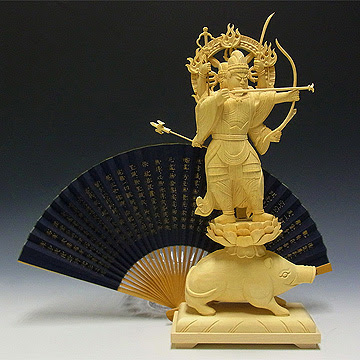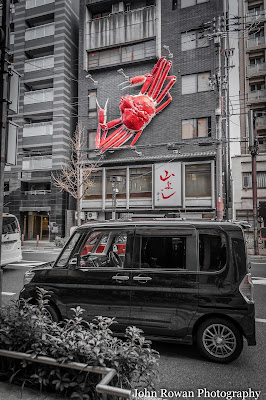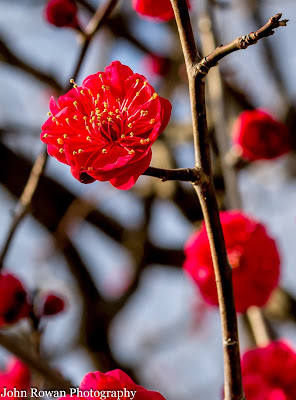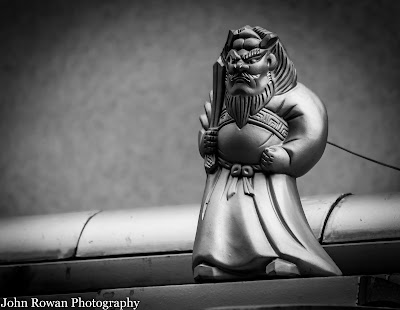Sunday 28 August 2016
Satisfaction
As a solitary Wiccan it can be hard to keep motivated and stay satisfied with your path. In May I moved to my new home and I am very happy here. But since the move both my photography and Wiccan practise have taken a back seat to my teaching and language study. I began to feel dissatisfied with this situation, but was not sure what to do. But then I remembered a little magick embedded in the word satisfaction, that is the word action. It does not have to be a big action, but if you do something to improve your satisfaction with something, this will lead to other positive changes. So I believe this small ritualistic action of photographing Ebisu and Benzaiten, then writing this post is enough to get my practise back into gear again. If there is something in your life that is unsatisfactory for you, do not wait for someone else to do something, be pro-active and do something positive to make the situation better. It will work like magick.
Thursday 18 August 2016
Imagining creation
I believe anything that someone creates is a kind of magick. First you have to be able to imagine it and imagine that you can create it. Without that positive imagination, creation is impossible. I strongly believe anything that we can visualise and believe in, we can bring into reality. An interesting thing in the Japanese language is the word (or I should say words) souzou, which has two meanings, imagine and create. The pronunciation is the same, but the kanji (Japanese characters) are different. I think this is a beautiful connection.
Saturday 30 April 2016
Moving Beltane
Beltane always seems a time of starting something new for me. Last year I started writing a blog about the Wiccan festivals in Japanese. This year I moved home. I lived in my wonderful flat by the river for two and a half happy years and it was sad to say goodbye. But now I am living in a fantastic flat up in the Kyoto sky. I have been too busy to do a ritual, but moving itself is a kind of ritual, saying goodbye to the old and hello to the new. I did find some time to take some pictures of the lush new greenery in Kyoto. Bright Beltane Blessings to you all.
http://wiccakyoto.blogspot.jp/2015/05/a-poem-for-beltane.html
http://wiccakyoto.blogspot.jp/2014/04/yellow-beltane-flowers-and-jack-in-green.html
http://wiccanwheeloftheyear.blogspot.jp/2015/05/beltane.html
Sunday 24 April 2016
Don't be chained to another person's spiritual beliefs
Today I found the above two statues chained together outside a
Buddhist shop in Kyoto. It was the final piece in a jigsaw of
events that inspired this post. At the moment I a trying to create
a Pagan Moot in Kyoto.I believe there are pagans in Kyoto,
but hiding in the shadows somewhere. I know that slowly and
surely the moot will grow, but as I expected, I was the only
person at the first one. The big advantage about being
the only person at a moot is nobody disagreed with me.
But strangely the worse thing was that nobody disagreed
with me. The great thing about paganism is that everyone is
following their own path, so there is agreement and disagreement,
but many chances to learn from other peoples paths.
Recently one of my most spiritually aware friends had
her spiritual beliefs attacked by a fundamental christian.
He went as far a saying her beliefs were evil. She is
Japanese so has had little contact with fundamental christians.
This bullying made me angry, but the worst thing for
her was his unwillingness to try to understand her path. If I
speak honestly, I have no time for any of the monotheist
religions, I believe they are fundamentally bad.
But because of my friends openness to everything,
she asked me to teach her about Christianity. At first I did not
want to, but after thinking about it, I would rather be
open as she is, than closed as her bully was.
Also I have some good Christian and Islamic friends who
have strong beliefs about Jesus; so I decided to write
about Jesus for her and in respect for them. When I was
young I attended a Church of England school, so
I knew a lot, but I also researched in the Catholic and
King james (not so witch friendly) bibles.
I learnt a lot and one thing that surprised me
was except for the Resurrection there is only one
miracle that is in all four gospels. It is the feeding of the
five thousand, which as always struck me as
being a metaphor for sharing and if society
shares there would be no poverty. So I read
it in the gospel of John and tried to translate
it into Japanese. These events have
made it very clear to me that we can learn from
all spiritual paths. But without the freedom
to walk our own path we can become slaves to another
persons path, that may or may not be spiritual.
Sunday 20 March 2016
Thursday 25 February 2016
ペイガンムート: Pagan Moot
イギリスではペイガンムートが多いです。ペイガンの意味は一神教(ユダヤ教、キリスト教、イズラム教)以外の宗教とかスピリチュアルな道です。例えば、ウィカ、伝統的な魔女の事とかドゥルイドです。たいてい、ペイガンのスピリチュアルな道は昔の多神教のような宗教です。ムートは昔の英語です。意味は集会です。ペイガンムートに行く人はたいてい、昔の宗教に興味深い人です。その人たちの場合、自然は非常に大切です。たくさんペイガン人はタロット、占星術、とか魔法に興味深いです。京都ではペイガンムートがないと思いますが、長い間私はそのイベントを作りたいと思っていました。今、私のイギリス人のペイガンの友達,Vickiさんは京都にいますので、突然京都のペイガンムートを作ろうと決めました。でも、もうすぐ彼女はイギリスに帰ります。でも、今から私は月に一回京都でペイガンムートを作るつもりです。今、時間と場所を考えていますが、もし興味があったら、連絡してください。ペイガン人とペイガンの事に興味がある人は来るのを歓迎します。一つルールがあります。みんなは自分のスピリチュアルな道を持っていますので、他の人の道を尊敬してください。
In Britain there are many Pagan moots. Pagan meaning, except for monotheistic religions (Judaism, Christianity, Islam...),religious or spiritual paths. For example: Wicca, Traditional Witchcraft, Druidry. Usually a Pagan spiritual path is like an ancient polytheistic religion. Moot is old English for gathering. Usually people who go to Pagan moots have a deep interest in old religions. For them nature is extremely important. Many Pagans have a deep interest in tarot, astrology and magick. I do not think there is a Pagan moot in Kyoto, but for a long time I have been thinking about creating this kind of event. At this time my Britsh Pagan friend Vicki is in Kyoto, so suddenly we decided to create a Pagan moot. She will be returning to England soon, but I will hold a moot once a month from now. Now, I am thinking about where and when, if you are interested, please contact me. Pagans or people who are interested in Paganism are welcome to come. There is just one rule: everyone has their own spiritual path, so please respect others paths.
Wednesday 10 February 2016
Japanese Valentine's Day
| Banner over a convenience store in Kyoto |
Even when I lived in England, I did not like Valentine's day, the commercialisation in my opinion makes it fake. Giving a loved one a gift is wonderful: but being dictated as to not only when to, but what kinds of gifts you can give, takes away both the romance and the true spirit of giving. Recently I saw a great video by the Welsh Pagan Witch, Tylluan Penry (linked below), she talks about both Valentine's day in regards to paganism and commercialisation. This inspired me to write about Japanese Valentine's day.
I do not think Valentine's day really has a connection with paganism, but at least in Europe there is a connection to Christianity. Saint Valentine was said to have married Christian couples and was executed by the Romans for this. Here in Japan there is no religious or spiritual meaning to the day. But for Japanese chocolate manufactures it is the most important day of the year. Some sources say they make half of their yearly profits from this day alone. Valentine's day first came to Japan in 1936, when the Morozoff chocolate company aimed advertisements at the expat community in Japan. But it really started in 1958, when the Isetan department store chain started to promote it.
Basically, it a day when women give chocolates to men and not just to there boy friends or husbands. There are many different types of these chocolate gifts. First 本命チョコ Honmei choco, this is for someone you have real feelings for. An off shoot of this is 友チョコ tomo choco, meaning friends chocolate, where women give their female friends chocolate. But now (in my opinion) it starts to get a little strange. Next we have 義理チョコ giri choco, meaning obligation chocolate given to male co-workers, male bosses or in my case male English teachers. On Valentine's day I will receive an obscene amount of chocolate. Some (I hope) from truly grateful students, but certainly a lot out of obligation. But I really hope none of it is チョウ義理チョコ chyou giri choco, ultra obligation chocolate.
So in Japan, Valentine's day has not been commercialised, because it was never part of the culture here. It was simply imported for commercial reasons and for the companies it has been a big success. But in the 1980s those companies realised that it could have been more successful. They had left men out of the equation, men were not spending any money. So a new day was invented with built in meanings in regards to how much money the men spent. The day was named "White Day"(March 14th) maybe after it's purity or maybe after it's pure commercialism. A man in a relationship should spend between two and three times more than his partner spent. To spend the same amount is to show friendship, so in a relationship it implies a cut. To not return a gift means the man sees himself as superior to the woman.
I think giving a gift is one of the best ways to show love, gratitude, or respect. It is also spiritually uplifting. But I would say there are 363 better days in the year, than Valentine's Day and White Day to do it. Interestingly, Valentine's day is not the most romantic day for dating in Japan, that goes to another western import, Christmas Eve.
Youtube video by Tylluan Penry about Valentine's day.
Monday 8 February 2016
摩利支天堂: A Shrine to the Goddess of Light
Yesterday I posted about a Sunday walk I took. One of the places I visited was a shrine with many statues of wild boar. I have been there many times, but knew little about it. A few people have asked me questions about it, so I did a little research. The name of the shrine is Marishitendou, named after an Indian goddess of light, whose Japanese name is Marishiten. She is usually pictured riding a boar or being pulled in a chariot by two boars.
Sunday 7 February 2016
Sunday Afternoon Walk
My Nikon DSLR camera is an amazing piece of modern technology, but for me it is a magikal tool. When it is around my neck, I slow down and see more. My Aries sun sign rushes me from one adventure to another at break neck speed. I am usually riding my bicycle from one job to another, the scenery constantly changing. But my camera brings out my Cancer rising sign, I take things much more slowly and think a lot more.
I do not usually take my camera down this street, but I often use it to move from place to place. Today I had my camera and for the first time I saw this derelict old wooden house covered in dead foliage and leaves. It is surrounded by modern buildings and has a sad neglected atmosphere. But at one time it must have been the newest building on the street, full of hope and optimism for the future.
Crossing back over the river to the east side (where I live) I looked for the kites that are usually circling over the river. They were absent today, which reminded me that I had seen them to the north east at Kyoto University on Wednesday. That day there was a festival at the nearby Yoshida Shrine and I thought then, that they were looking for the chance to steal food. So maybe today they have found another event.
I came across a fortune tellers shop, which had a sign reminiscent of a doctor's clinic. But it had moons and a star indicating times when he gives reading at other places. It made me wonder how he and his clients view fortune telling.
I dropped into Ebisu shrine and noticed that two people had left there old wallets on a special sacred stone there. Many Kyoto people do this when they buy new ones. My old one will be there soon. I am looking for a new yellow wallet, Japanese people believe they are lucky, so I will give it a go.
I crossed the street to the shrine with many images of wild bore. I do not know the meaning, one day I should really ask, but not today. A day when I do not have my camera.
Finally a quick stop at the second hand shop and a look at the old post cards. Among them is a picture of a young beautiful woman, probably taken a long time ago by a better photographer than me. I wonder if he used a Nikon? I will never know, but I know whatever camera he used, it was magickal for him.
Sunday 31 January 2016
Imbolc's Call
It is two days away from Imbolc and here in Kyoto something is stirring. This morning the winter light's harshness seemed to be softening; one of the first signs of spring. I had a lot to do today, but somehow I new I had to make time to visit an old friend in the afternoon. This old friend is an Ume tree (plum). If trees have astrological signs, this one is an Aries. It is about two weeks away from when most Ume will start to bloom and about four weeks away from full blossom. But from past experience I knew this one does not have the patience to wait and by Imbolc beautiful red flowers are starting to bloom. I was not disappointed.
Thursday 21 January 2016
Tiny Statues on the Roof
On many of the traditional houses in Kyoto you find tiny statues. They are there to protect the house from evil spirits, the are a kind of amulet or in Japanese mayoke 魔除け. I believe they are depictions of Enmadaiou 閻魔大王、who is a judge in Meido 冥土,the kingdom of the awaiting dead. Those that he judges to be evil are sent to Jigoku 地獄, Hell. Basically the statues are reflecting evil spirits away from the house. But that can mean in Kyoto's traditional narrow streets, that you are sending the spirits to the house across the street. So it is not uncommon to see two of these statues facing each other.
Sunday 10 January 2016
Mysterious Tarot
Yesterday, I was walking through the back streets of Kyoto taking pictures, when I came across a fortune teller's shop. This is not so unusual there are many fortune tellers in Kyoto, but I found the sign to be intriguing. "Witches" written in English, first caught my eye, but it was the Japanese that caught my interest. I could not read the first two characters together, but I knew them. The first is kami, god and the second I recognised but could not remember. The remaining Japanese was easy to read, no meaning belonging to, and Tarot. So I took a picture of the sign to check later.
Today I remembered the sign and decided to check. The word is shinpi , meaning mystery or more precisely the mysteries. So I translate it as "The Tarot of the Mysteries". Which started me thinking about how mysterious the Tarot is. The Japanese word shinpi is generally used for example in: the mysteries of the sea, the mysteries of the universe. So what kind of mystery is the Tarot a part of? For me, the Tarot belongs to the mysteries of symbols. Along with runes, dreams and so on, it communicates to our subconscious through images. This brought me back to the fortune tellers sign: obviously I could read the English word witches and to some extent the Japanese too, but was something symbolic happening as well?
There is a crescent moon on the sign and a pentagram embedded in to the katakana character タ. So I believe that if the word witches was replaced by the Japanese word 魔女, still a non-Japanese reading: tarot reader, wiccan, pagan or so on would be drawn to the sign and gain some meaning from it.
The biggest mystery for me is how symbolically the Tarot consistently creates the story to be told. We say to read the Tarot, but that has a nuance of interpretation, but I feel it is more like narration. I remember when I first started to read the Tarot, I was young and somewhat shy, but the words flowed effortlessly when I gave readings. Now when I give readings in Japanese, I am much more fluent than at other times. The symbolism of the Tarot flows through me.
It is the time of the new moon in Capricorn, while walking back from a shrine dedicated to my chosen god Ebisu, I instinctively took a road I had never taken before and found this fortune teller's shop. Is there any symbolic meaning? The answer is simple, yes.
Bright Blessings
Subscribe to:
Posts (Atom)


























